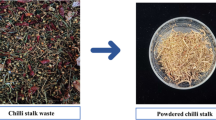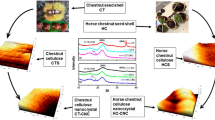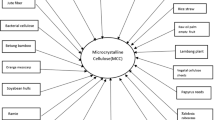Abstract
Microcrystalline cellulose has applications in food, pharmaceuticals, and other industries. Most microcrystalline cellulose (MCC) is produced from dissolving pulp using concentrated acids. We investigated steam explosion treatment of corn cobs and cotton gin waste for the production of microcrystalline cellulose. The corn cob was converted into a coarse brown powder after steam explosion and the lignin and residual hemicellulose fractions were extracted respectively with sodium hydroxide solution and water. The residual cellulose was readily bleached with hydrogen peroxide and converted to microcrystalline cellulose using hydrochloric acid, sulfuric acid and cellulase enzyme preparation. The resulting microcrystalline cellulose samples had properties that were similar to commercial microcrystalline cellulose. Similarly, cotton gin waste was steam exploded and converted into microcrystalline cellulose, but this material was more difficult to bleach using hydrogen peroxide. The degree of polymerization for the MCC samples ranged from 188.6 to 549.8 compared to 427.4 for Avicel PH101 MCC.







Similar content being viewed by others
References
Battista OA, Byrne JJ Jr (1965) Cellulose crystallite aggregates in chromatographic adsorption. US Pat 3,179,587
Battista OA, Cruz MM, Ferraro CF (1971) Colloidal microcrystal polymer science in surface and colloid science. Wiley-Interscience 3:244
Battista OA, Smith PA (1961) Level-off degree of polymerization cellulose products. US Pat 2,978,446
Battista OA, Smith PA (1964) Crystallite cellulosic aggregates prepared in an acid medium. US Pat 3,141,875
Battista OA, Smith PA (1962) Microcrystalline cellulose. Ind Eng Chem 54:20–29
Brittain HC, Lewen G, Newman AW, Fiorelli K, Bogdanowich S (1993) Changes in material properties accompanying the national formulary (NF) identity test for microcrystalline cellulose. Pharm Res 10(1):61–67
Chen J, Yan S, Ruan J (1996) A Study on the preparation, structure, and properties of microcrystalline cellulose. J Macromol Sci––Pure Appl Chem A33(12):1851–1862
Christy MG, Samfield M (1960) The Average degree of polymerization (D.P.) of cellulose in various tobacco types. Tob Sci 4:33–37
Garnier G, Bouchard J, Overend RP, Chornet E, Vidal PF (1990) High yield production of microcrystalline cellulose by a thermo-mechano-solvolytic treatment. Can J Chem Eng 68:113–118
Intrinsic Viscosity of cellulose in cupriethylenediamine, Viscotek DSV application Note No. 5
Jeoh T, Agblevor FA (2001) Characterization and fermentation of steam exploded cotton gin waste. Biomass Bioenerg 21(2):109–120
McCabe W, Smith J, Harriot P (2004) Unit Operations of Chemical Engineering. McGraw Hill, Chemical Engineering Series, p. 967
Merkblatt IV/36/61, Bestimmung der Gernzviskositätszahl (GVZ) von Cellulose in Kupferäthylendiamin=Lösung (Cuen)
Nelson ML, O’Connor RT (1964) Relation of certain infrared bands to cellulose crystallinity and crystal latticed type. Part I. Spectra of lattice types I, II, III and of amorphous cellulose. J Appl Polymer Sci 8(3):1311–1324
Rowland SP, Roberts EJ, Bose JL (1971) Availability and state of order of hydroxyl groups on the surface of microstructural units of crystalline cotton cellulose. J Polym Sci A1 9(5):1431–1440
Ruan R, Lun Y, Zhang J, Addis P, Chen P (1996) Structure-function relationships of highly refined cellulose made from agricultural fibrous residues. Appl Eng Agric 12:465–468
Taherzadeh MJ, Niklasson C (2004) Ethanol from lignocellulosic materials: oretreatment, acid and enzymatic hydrolyses, and fermentation In: Saha BC, Hayashi K (eds) Lignocellulose biodegradation. ACS Division of Cellulose and Renewable Materials, American Chemical Society, Washington, DC, pp 49–68
Uesu NY, Pineda EAG, Hechenleitner AAW (2000) Microcrystalline cellulose from Soybean husk: effects of solvent treatments on its properties as acetylsalicylic acid carrier. Inter J Pharm 206:85–96
Acknowledgment
The authors acknowledge the USA-Egypt Science and Technology Program, USDA, NSF, and Xethanol LLC for funding the project. Genencor International for supplying the enzyme, and Bob Wright for conducting the steam explosion experiments.
Author information
Authors and Affiliations
Corresponding author
Rights and permissions
About this article
Cite this article
Agblevor, F.A., Ibrahim, M.M. & El-Zawawy, W.K. Coupled acid and enzyme mediated production of microcrystalline cellulose from corn cob and cotton gin waste. Cellulose 14, 247–256 (2007). https://doi.org/10.1007/s10570-006-9103-y
Received:
Accepted:
Published:
Issue Date:
DOI: https://doi.org/10.1007/s10570-006-9103-y




